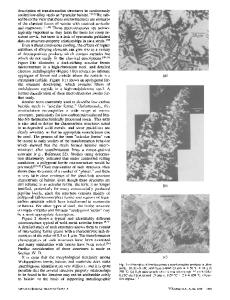Microstructure-mechanical property relationships in isothermally transformed vanadium steels
- PDF / 4,282,033 Bytes
- 12 Pages / 594 x 774 pts Page_size
- 13 Downloads / 285 Views
I.
INTRODUCTION
THEinterphase precipitation reaction occurs in vanadium steels by the direct decomposition of austenite to ferrite with vanadium carbide, carbonitride, or nitride particles being precipitated at the austenite: ferrite interphase boundary during the transformation. ~-6 Planar sheets or curved boundary arrays of particles are observed by transmission electron microscopy 7's and are responsible for significantly increasing the yield strength of vanadium-microalloyed high strength low alloy (HSLA) steels. 9-13 However, the interphase precipitation strengthening has a deleterious effect on impact toughness levels, which is usually improved by grain refinement through, for example, normalizing or controlled rolling. 14-,a Recent studies by Mishima H'19and Todd and Parker, 2~of isothermally transformed Fe-C-V alloys, have shown that when the VC interphase precipitate morphology is combined with a large prior austenite grain size ( - 2 0 0 / ~ m for austenitizing temperature 1200 ~ high strength but extremely brittle microstructures result, regardless of the transformation temperature. However, for an austenitizing temperature of 1000 ~ (ferrite grain size - 1 0 to 15 txm), a distinct difference was observed between samples transformed at temperatures above and below the nose of the ferrite C-curve. The above nose transformation products gave room temperature Charpy impact toughness values of 228 J compared to 3 J for microstructures developed at the lower temperatures. This extreme degradation in toughness level was attributed by Mishima ~9 to the presence of a fibrous vanadium carbide morphology, and it was proposed that the elimination of this morphology would restore the high impact values. According to Honeycombe, 5 precipitation of fibrous VC is rare (~5 pct total VC precipitate) in an isothermally transformed Fe-0.2C-t.0V steel, but Batte, 2~ Edmonds, 22 J. A. TODD, Assistant Professor, and P. LI, Graduate Research Assistant, are with the Departments of Materials Science and Mechanical Engineering, University of Southern California, Los Angeles, CA 90089-0241. Manuscript submitted July 15, 1985. METALLURGICALTRANSACTIONS A
and Law 23 have shown that additions of 1.5 pct Mn or 1.5 pct Ni can increase the fibrous morphology to - 2 0 pct of the total VC precipitate. The present study was undertaken to make a systematic study of the microstructures in an isothermally transformed Fe-0.2C-1.0V-0.5Mn steel and to investigate the role of the interphase and fibrous vanadium carbide morphologies in determining the strength and impact toughness levels of this steel.
II.
EXPERIMENTAL PROCEDURE
A. Material
The chemical composition (weight pet) of the steel used in this study was Fe-0.19C-I.14V-0.45Mn-0.001N. The alloy was prepared from high purity elements (99.9+ pct) and induction melted under argon in a magnesium oxide crucible. A 10 kg, 7 cm diameter ingot was cast in a copper mold in an argon atmosphere. The ingot was upset forged at 1200 ~ in air and cross rolled to a rectangular section 7 cm wide by
Data Loading...










